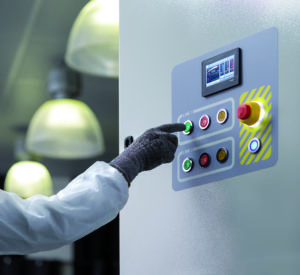This is the second in a four-post series explaining the benefits of microgrids for hospitals. In my last post I discussed how microgrid technology is now fully mature, and the main features you can expect to be included. In this post, let’s take a deeper look at how a microgrid delivers higher resilience, cost savings, and sustainability.
First, it’s helpful to have an understanding of how a microgrid operates. Your facility will typically have a combination of distributed energy assets (DER), such as a combined-heat-and-power system, solar panels or wind generation, fuel cells, and energy storage. DER can also include any flexible non-critical loads.
All DER are managed by a microgrid controller (with associated software) and a network of smart, connected metering and control devices. There might also be a cloud-hosted app delivering additional energy analytics. Let’s see how all of this works together.
 Enhancing resilience
Enhancing resilience
The microgrid controller has a few important responsibilities. If there is a utility grid outage, it will safely disconnect to ‘island’ from the grid, support critical loads, then reconnect after the event. The controller also ensures facility-wide electrical network protection is maintained in grid-connected or island mode.
When connected to the utility grid, DER is managed so that renewable energy is consumed as much as possible, or saved to the storage system, or sold to the grid. In island mode, onsite energy production is balanced against consumption. With enough onsite resources, the entire hospital can be powered for an extended period.
Advanced microgrid solutions can provide proactive protection by ‘looking ahead’ to approaching conditions (like a storm) and prepare to island from the grid, giving facility personnel enough time to take precautionary measures. Islanding from the grid can also be enacted to avoid poor power quality conditions, such as transient spikes from lightning that might affect sensitive hospital equipment.
As noted in my last post, without a microgrid, the combination of traditional diesel backup generators and UPS can supply critical circuits, but only for a limited time. And there is a risk that those generators may fail to start up. With a microgrid in place, increasing levels of DER will offer increasing levels of resilience:
- If the facility is equipped with renewable energy sources, backup generators will still be engaged as a first line of defense against a grid outage. But if backup generators fail or reach their runtime limit, the microgrid controller can engage renewable sources and energy storage to supply critical circuits. While backup generators are supplying critical loads, renewables can also be used to supply additional circuits.
- A CHP system will run continuously, supplying (at least) the partial electrical needs of the hospital. If an outage occurs, CHP can provide a ‘flicker free’ transfer from grid connection to island mode. If CHP is sized large enough, backup generators will not need to be engaged at all.
- For the ultimate level of resilience and services availability, CHP is combined with renewables, achieving near-unlimited autonomy depending on the CHP fuel supply. In this case, renewable resources can serve any additional loads not taken care of by the CHP system.
Saving money while going green
As noted by Mark Feasel, Vice President of Smart Grid at Schneider Electric, “Now with PV and CHP with natural gas, in many states [within the USA] you can generate energy cheaper than you can buy it.” This means that while a microgrid helps a hospital maximize resilience, it can simultaneously optimize energy costs and maximize the use of renewable energy.
Even in regions where energy from the grid is not always more costly, the energy flexibility and functional value of DER can be fully monetized to achieve cost savings. The energy analytic capabilities I mentioned earlier are the key to these opportunities.
A microgrid analytic app will integrate a wide range of relevant data, including:
- weather prediction
- solar and wind availability
- energy market pricing (electricity, natural gas, hydrogen, and diesel)
- facility occupancy and activity schedules (e.g. electric vehicle charging).
Based on these inputs and advanced modeling, the app determines the best times to produce, consume, store, or sell energy to minimize costs and maximize sustainability. It then works together with the microgrid controller to take action. The more flexibility the microgrid has in terms of onsite generation, energy storage, and controllable loads, the more opportunities there will be.
A microgrid system can intelligently help avoid utility bill demand penalties by temporarily reducing the amount of energy consumed from the grid to avoid a demand peak. This can be done by consuming more onsite energy from renewables, storage, or CHP. Though options may be limited, another strategy is to turn off any non-critical loads, such as EV charging.
In regions with variable energy pricing, the microgrid can respond to pricing signals. During periods of high grid energy cost, more onsite energy can be consumed, including from storage. Through load shifting, non-critical activities can be scheduled to run during ‘off peak’ periods. Similarly, a building management system can be programmed to pre-cool areas based on the solar heating forecast.
A microgrid also makes it easier to participate in ‘smart grid’ programs like demand response (DR), if offered by the grid operator. A hospital can receive payments for the amount of load capacity it can reduce during any time the supply of electricity on the grid is threatened. The microgrid offers a flexible choice of using local generation, stored energy, or load management to comply with a curtailment request.
Finally, a microgrid offers a great opportunity to optimize sustainability. Self-consuming low-cost, renewable energy helps reduce energy-related GHG emissions. The microgrid can be programmed to maximize the use of renewables by intelligently managing solar and wind generation, as well as energy storage.
In my next post, we’ll start looking at the important considerations a hospital team needs to keep in mind when planning for a microgrid. To learn more about the topic of this post, download the white paper “How new microgrid designs help hospitals increase resilience, cut costs, and improve sustainability.” Schneider Electric provides complete microgrid expertise and integrated solutions for hospitals. Discover these at our microgrid solutions page.



